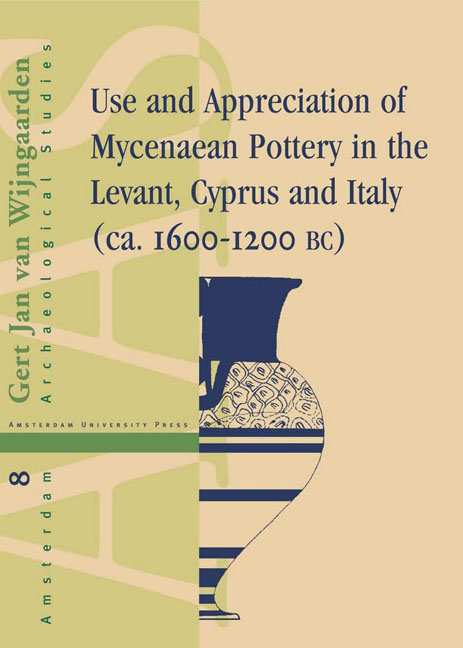19 - Variations in the Cultural Significance of Mycenaean Pottery
Published online by Cambridge University Press: 10 February 2021
Summary
MYCENAEAN REPERTOIRES
As is clear from the discussions in chapter 2, the Levant has the most sites with Mycenaean pottery, but the density is highest in Cyprus, as is the absolute number of pots. A common characteristic of the distribution pattern in all areas is that everywhere a large number of sites has produced very few Mycenaean finds, while only a few sites have yielded substantial quantities of it. Several large urban centres along the Levantine coast have produced large amounts of this pottery; however, it also occurs in quantity at sites in the interior of the Levant. This was not the case in Cyprus, where extremely large quantities of Mycenaean pottery have been found exclusively at sites near the coast. Just as the coastal cities of the Levant, all Cypriot urban centres with major deposits of Mycenaean pottery are towns which played important roles in regional and supra-regional trade networks. In Italy, too, the places which have produced substantial quantities of Myceanean pottery can be understood as nodes where international and regional exchange systems coincided. In comparison with the Levant and Cyprus, however, clear shifts in time can be noted with regard to the sites in the central Mediterranean with large quantities of Mycenaean pottery. The unequal presence of large quantities of Mycenaean pottery, which is characteristic of all areas, suggests that everywhere this pottery was imported in only a few places, after which it was distributed through regional exchange networks.
In Cyprus, a few LH I-LH IIA pots have been found, while some contemporary Minoan pottery is also present on the island. An increase in the Aegean imports in the island may be noted during the LH IIB and especially during the LH IIIA1 ceramic phases, of which substantially more finds have been made, even in places far away from the coasts. From LH IIIA2 onwards, large quantities of Mycenaean pottery reached all parts of the island. This remained the case until an advanced stage of LC IIC, when pottery in Aegean style began to be produced on the island itself and Aegean imports diminished.
- Type
- Chapter
- Information
- Use and Appreciation of Mycenaean Potteryin the Levant, Cyprus and Italy (1600-120O BC), pp. 261 - 274Publisher: Amsterdam University PressPrint publication year: 2002

